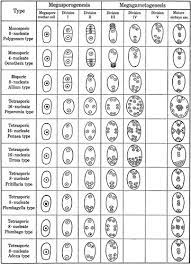Cytological Evidence for Crossing Over
Cytological Evidence for Crossing Over
Crossing over is the exchange of chromatid blocks between chromosomes
during meiosis. The crossing over occurs during the le stage of meiosis. This
is proved by cytological evidences.
1. Stern's experiment.
2. Tetrad analysis
3. Creighton and Mc Clintock's Experiment
1. Stern's Experiment:
Crossing over is the interchange of chromosomal parts between
homologous chromosomes. This is cytologically proved by Stem Drosophila. The
female Drosophila carries XX chromosome and the m Drosophila carries one X
chromosome and one Y chromosome
In a type of female Drosophila, the two X chromosomes
different from each other. An X chromosome has a piece of Y chromosome attached
to it. The other X chromosome has been broken into two unequal segments and it
is shorter than the unbroken X chromosome. Thus, the two X chromosomes are
structurally different from the normal X chromosomes. Both the chromosomes can
be distinguished by microscopic examination. In Drosophila, red eye (C) is
dominant and carnation eye recessive (c). Similarly bar eye is dominant (B) and
round eye (b) recessive.
1. Carnation bar
2. Red round
3. Carnation round and
4. Red bar
The X chromosome of these four types are then identified. Each offspring has the expected chromosomal configuration. Phenotypically the red bar eye fly is a product of crossing over The crossing over is also evident by the cytological observation of the fly. The fragment of Y chromosome, which was attached to the mal size X chromosome in the parent, is now attached to the short, broken X chromosome in the red bar eye fly of F1. Similarly, phenotypically the carnation round eye fly is a prod of crossing over. The crossing over is also evident by the cytologic observation of this fly. It has a normal chromosome, which was a normal in the parent. This experiment proves that interchange of chromosomal mar rial takes place between the homologous chromosomes.
2. Tetrad Analysis:
Tetrad analysis is a technique of using individual spores tetrad ascus to study occurrence of crossing over at the four chromatid stage. Lindegren (1933) proved that crossing over occurs at a for strand stage and involves only two of the four strands at any o place in Neurospora crassa. Neurospora crassa is a red bread mold. In Neurospora, each ascus contains 8 haploid spores arranged in a serial order. They have arisen from a single diploid nucleus through two meiotic division and one mitosis. The ascospores are arranged as per the order of meiotic and mitotic divisions. The 8 ascospores are arranged in a serial order as per division in the ascus and they can be dissected out and grown separately, giving rise to haploid individuals that show the genetic constitution of each gamete.
Let us assume two strains of Neurospora, one with AA gene type and another with aa genotype. They are crossed. If crossing over occurs in the bivalent stage, the ascus will contain ascospores in the order of 4:4. If crossing over occurs in the tetrad stage, the ascus will contain ascospores in the order of 2:2:2:2.
3. Creighton and Mc Clintock's Experiment:
Creighton and Mc Clintock's proved experimentally, the e
change of chromatids during crossing over in maize. They used t strains of
maize which showed differences in the 9th chromosomes. one strain, the 9th
chromosome has knob at one end and a cell marker at the other end. The second
strain has no knob and no cell marker. In addition, two genetical characters
are selected. They are colour of kernel and nature of endosperm. Coloured
kernel is dominant (CC) and colourless kernel is recessive (cc). Starchy endosperm
is dominant (WXWX) and waxy endosperm is recessive (wxwx). A maize with knobbed
chromosome, coloured kernel and waxy endosperm is crossed with another maize
having knobless chromo some, colourless kernel and starchy endosperm. Hybrid
maize having heterozygous chromosomes and heterozygous genotypes are produced in
the F1. The F1, hybrid is test crossed with a double recessive maize having
knobless chromosome. The F2, plants are examined genetically and cytologically.
The experiment shows the following new combinations.
All coloured starchy
plants have knobbed chromosomes.
The colourless waxy plants have knobless chromosome. These
plants have cell marker in the chromosome.
The knobbed coloured starchy plant is a new combination. It has a knobbed chromosome. The knob of this chromosome is received from the parent plant, knobbed coloured waxy, by crossing over. Similarly the knobless colourless waxy plant is a new combination. The knobless chromosome of this plant has a cell marker. The cell marker is received from the parent plant, knobbed coloured waxy, by crossing over.







Comments